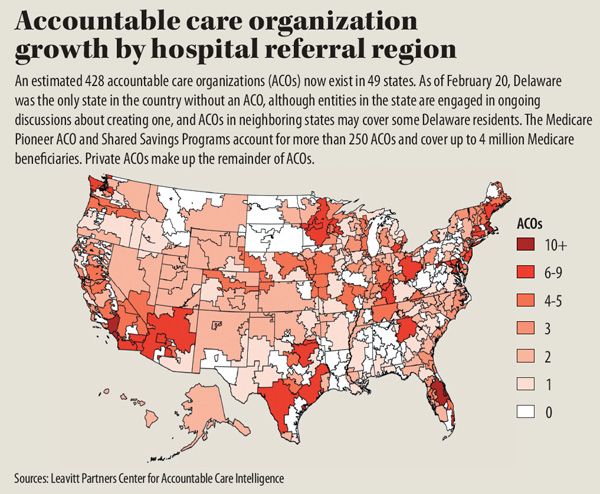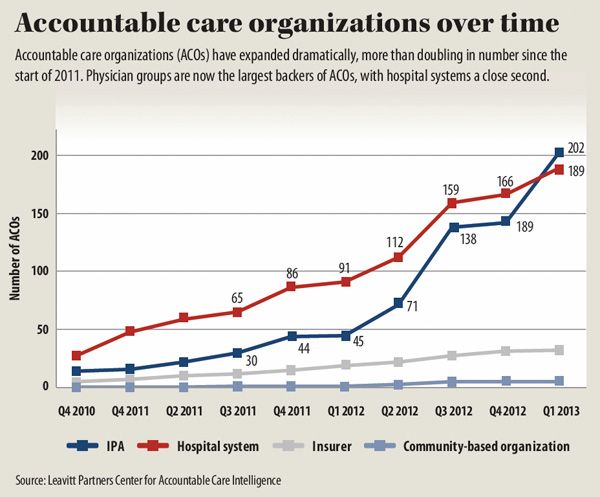Article
How ACOs will transform the ties between primary care and specialists
ACOs are changing the face of healthcare. Learn how they will change the ties between primary care and specialists.
Accountable care organizations (ACOs), with their overriding goal of getting patients the right care at the right time in an efficient way, might be the vehicle that finally elevates primary care to a status equal to specialty care, because primary care is the key to ensuring ACO revenue streams.

“You always hear about people building a new heart tower, but no one builds primary care towers,” quips Bruce Bagley, MD, interim president and chief executive officer of TransforMED, a subsidiary of the American Academy of Family Physicians. “Maybe that is about to change.”
TransforMED was created after studies showed that primary care was going to be strangled unless change occurred.
“We need to hold up our successes to show how a redesign of the system requires primary care to have a central role,” Bagley says.
He predicts that ACOs, and the changes they bring, represent the future of healthcare.
“Value-based purchasing requires a very different structure for how payments are distributed,” he says. “There are currently no incentives for clinicians to take shared responsibility for cost and quality. ACOs will require us to manage global payments in a way that is antithetical to fee-for-service.”
CHANGING INTERACTION WITH SPECIALISTS
ACOs also are expected to redefine the relationships between primary care physicians (PCPs) and specialists.
“All players will have to start to have a conversation about how to accomplish good patient care in a more effective way,” Bagley says. “[PCPs] and specialists will be required to work together to achieve these goals. We need to discuss each other’s role, such as what a [PCP] can do to get a patient ready to see a specialist.”
Such conversations sometimes occur in multispecialty group practices in which physicians are salaried, but they are more rare when doctors work separately, he says.
“We need a shared understanding of how to handle common conditions and have a team approach to efficient diagnoses and treatment regimens. If the ACO model is working well, primary care should be the central focus that sends patients to the right place at the right time,” Bagley says.

Neil Kirschner, PhD, senior associate of regulatory and insurer affairs at the American College of Physicians, says that ACOs will make it more important than ever for PCPs to be aware of what is happening with the patients they refer to specialists.
“The [PCP] can be hurt financially if the specialist isn’t doing [his or her] job correctly,” he says.
Part of this process is making sure the right information is given to the specialist from the start. Ensuring that test results get to the specialist in a timely way, for example, will reduce costly redundancies.
Although Bagley stresses that the restructuring that will come with ACOs is not about putting more money in doctors’ pockets, he does predict that primary care ultimately will be rewarded because it will be better able to contribute to the overall process of delivering appropriate care.
Part of keeping all of the members of an ACO “on their toes,” however, may be allowing PCPs to refer to outside providers if they do not believe certain ones in an ACO are operating efficiently, he says. Bagley acknowledges, however, that some ACOs will resist offering such an ability.
Catherine Leape, assistant director of recognition programs at the National Committee for Quality Assurance (NCQA), predicts that as ACOs transcend healthcare delivery from “site” care to “population health” care, it will be good for all physicians.
“Our current delivery system works in silos, and ACOs break down those barriers so that care management, coordination, and transitions from one provider to another are seamless. This has a very positive effect for all providers by promoting continuity of care and reducing duplicative tests or procedures,” she says.
The NCQA offers an ACO accreditation program to assist organizations in making the transition to integrated care. “As primary care is of the utmost importance, we were sure to align our accreditation program with our Patient-Centered Medical Home (PCMH) recognition, a program that recognizes excellence in primary care,” she says.
CHANGING DYNAMICS
The ACOs that succeed will be the ones that break the cycle of sick people showing up in the emergency department because they had no other access to care.
In the process, the reimbursement focus will shift from being volume-based to being value-based, Kirschner says. “Payments will be weighted toward quality and efficiency.”
Practices will receive a budget-likely a generous one, he says-to care for a population. The better the job they do at keeping quality high and costs down, the more they will be rewarded.
Several models exist in which this can happen through Medicare (see “ACOs across the United States”), and private payers are likely to follow suit, he says. Some of the models require no risk for the providers if they do not meet their saving targets.
“The government knows this is a major change and is trying to make it as easy as possible,” Kirschner says.
The only upfront costs some practices will need to face will be those related to implementing procedures to succeed in these new models, he says. Examples could be offering extended office hours, having a person good at triage take after-hours calls, and making sure patients are seen quickly and treated appropriately after being hospitalized.
“Once you get good at these things, you can start to assume some risk” and eventually move into more of a “capitated” model, Kirschner says.
According to TransforMED, primary care provides access, disease prevention, disease management, and care coordination services that leverage overall cost savings for the system. Other components of an ACO could include specialty care, imaging, laboratory services, hospital care, and information technology support.
“Each component must be integrated and coordinated and contribute to the overall efficiency of the ACO enterprise,” Bagley says.
He predicts that the ACOs that will achieve the best results are ones that are already mastering clinical integration. That is why moving toward a PCMH model is a recommended step on the path to becoming an ACO. It also lets you demonstrate your quality and efficiency to any ACO in your community seeking primary care services, he adds.
TransforMED recommends that, for the time being, PCPs keep seeing patients to optimize their revenue in the current payment environment. Mastering proper coding, having good billing procedures, and paying attention to accounts receivable also are critical to being able to respond quickly as the incentives change.
“Pay attention to what is happening in your market, and determine which players seem to value primary care as more than just a referral hub for hospitals and specialists,” Bagley says.
Kirschner also recommends that physicians stay up to date in areas such as contracts and the use of data to improve outcomes. “Providers need to be knowledgeable about many more things,” he says.
ANTI-KICKBACK LAWS
Another area in which physicians need to become more knowledgeable is anti-trust laws. As providers collaborate to provide care, they need to adhere to legal guidelines.
Consolidation of healthcare services within a market carries a high risk of monopolistic behaviors with resulting higher costs and controlled access. According to TransforMED, on the same day that CMS published the proposed rules for ACOs, the Department of Justice and the Federal Trade Commission also published rules that allow a certain level of consolidation and market share for health care organizations.
Kirschner says that physicians should be fully aware of those rules, because following them will offer substantial protection. Although professional legal advice on this topic has no substitute, practices should ask questions to identify potential problems. (See “What to ask," below.)
ACOs across the United States
In January, the Centers for Medicare and Medicaid Services (CMS) announced 106 new accountable care organizations (ACOs).
They include a diverse cross-section of physician practices throughout the country, according to CMS. Roughly half are physician-led organizations that serve fewer than 10,000 beneficiaries. Approximately 20% of ACOs include community health centers, rural health clinics, and critical access hospitals that serve low-income and rural communities
These 106 organizations bring the total number of CMS-approved ACOs to 252, according to the agency. Although many of these are shared savings programs, other alternatives are available:
Advance payment model. According to CMS, 35 of these ACOs are functioning under the advance payment model. Through this model, participants receive upfront and monthly payments that they can use to make important investments in their care coordination infrastructure. This arrangement is meant to help smaller ACOs with less access to capital. These organizations will receive an advance on the shared savings they are expected to earn.
Pioneer ACOs. CMS says 32 ACOs are participating using the Pioneer ACO model. This model is designed for health care organizations and providers who already are experienced in coordinating care for patients across care settings. It will allow them to move more rapidly from a shared savings payment model to a population-based payment model on a track consistent with, but separate from, the Medicare Shared Services Program. It is designed to work in coordination with private payers by aligning provider incentives, which aim to improve quality and health outcomes for patients across the ACO and achieve cost savings for Medicare, employers, and patients.
Advice from the field
In a recent Web seminar offered by the National Committee for Quality Assurance and titled “Lessons from the first accredited ACOs,” participants represented organizations that had voluntarily submitted their accountable care organizations (ACOs) for accreditation by the organization.
Some advice offered by these early adopters:
Hal Teitelbaum, MD, JD, managing partner and chief executive officer of Crystal Run Healthcare: Change your mindset. You are no longer selling office visits. You are selling good outcomes. With time, this will lead to lower costs.
If you are torn between value and volume because your patients have a variety of payer situations, choose a value-based approach for all, and partner with like-minded payers, providers, and suppliers.
Trude Haecker, MD, medical director, quality improvement department patient safety officer at the Children’s Hospital of Philadelphia Care Network: The Patient-Centered Medical Home model is a crucial framework from which to launch an ACO formation process. Also, use the ACO creation process to open dialogues with specialists on how you all can use electronic health record systems in new ways to improve outcomes.
Spencer R. Berthelsen, MD, chairman and managing director of Kelsey-Seybold Clinic: Do not minimize the value of having good medical leadership.
Douglas Carr, MD, medical director of education and system initiatives, Billings Clinic: An independent accreditation process is a useful way to review and improve your internal processes.
What to ask
Ask these questions when considering joining an accountable care organization (ACO).
- What are the ACO’s by-laws, and do they protect my interests?
- What representation will I have on the ACO’s governing body?
- What are the administrative and organizational requirements to participate (for instance, pertaining to data submission, committee participation, etc.)?
- What practice transformation changes will be required to participate (for instance, use of an electronic health record system, 24/7 access or triage, provision of case management)?
- What financial or “in kind” assistance can I expect from the ACO to implement and maintain any required practice transformation?
- What are reasonable estimates of shared savings or extra payments that the ACO can earn?
- How will any earned shared savings or extra payments be distributed?
- Is there any potential for accrued loses and participation in a “pay back” to the payer?
- Is the ACO adequately protected from relevant federal and state penalties (related to anti-trust and anti-kickback statutes)?
- What are the advantages and disadvantages of ACO participation versus establishing an independent service contract with the ACO, particularly for subspecialty physicians?
Source: American College of Physicians







